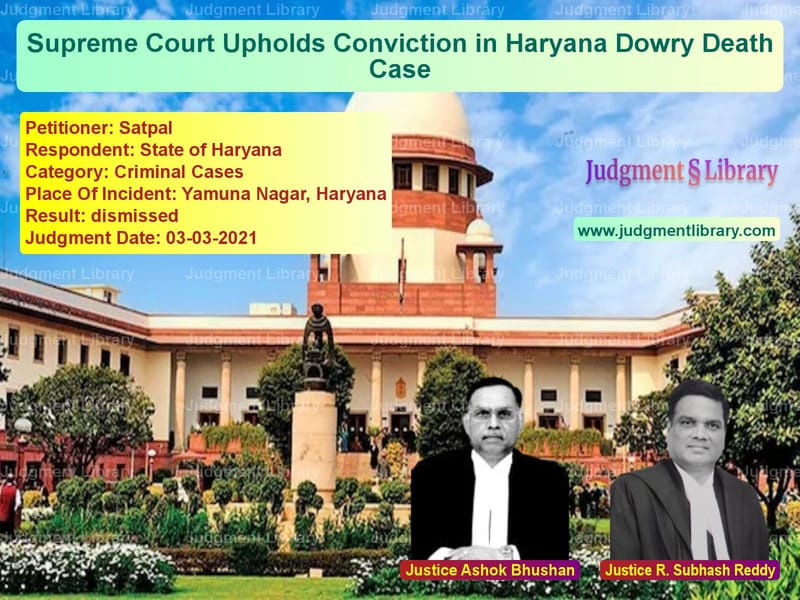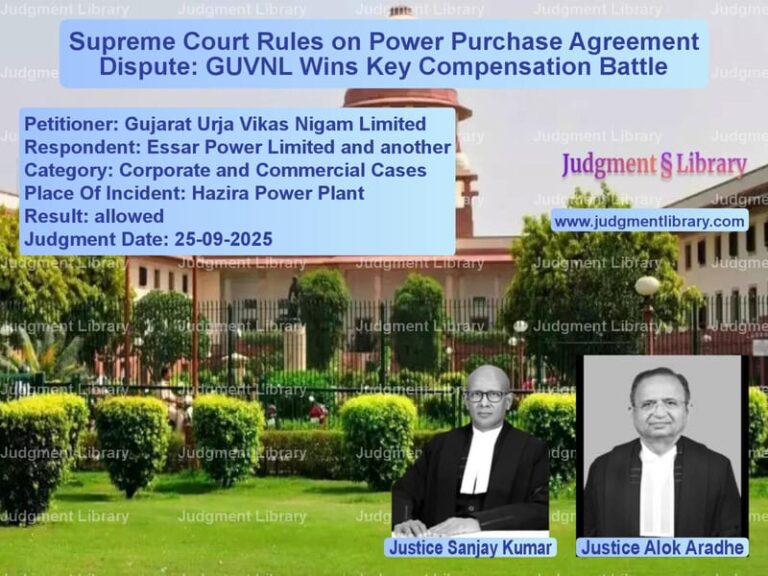Supreme Court Upholds Conviction in Haryana Dowry Death Case
The case of Satpal vs. State of Haryana revolves around the tragic death of Pooja Rani due to burn injuries and the legal battle to establish the guilt of the accused, her husband, under Section 302 of the Indian Penal Code (IPC). The Supreme Court examined whether the dying declaration of the victim, coupled with corroborative evidence, was sufficient to uphold the conviction.
Background of the Case
On March 20, 2008, Pooja Rani was admitted to J.P. Hospital, Yamuna Nagar, with severe burn injuries. The police registered an FIR under Section 307 read with Section 34 IPC, which was later converted to Section 302 IPC following her death on March 27, 2008. The investigation revealed that Pooja Rani had suffered 90% burn injuries, and her dying declaration was recorded by Judicial Magistrate First Class (JMFC), Ms. Kumud Gugnani.
In her dying declaration, Pooja Rani stated that her husband, the appellant Satpal, had poured kerosene oil on her and set her ablaze. Following an extensive trial, the Additional Sessions Judge, Yamuna Nagar, convicted the appellant under Section 302 IPC and sentenced him to life imprisonment. The conviction was later upheld by the Punjab and Haryana High Court, prompting an appeal before the Supreme Court.
Key Issues Before the Supreme Court
The Supreme Court was asked to determine:
- Whether the dying declaration recorded by the Magistrate was reliable.
- Whether there was sufficient corroborative evidence to sustain the conviction.
- Whether the conviction under Section 302 IPC was justified based on the available evidence.
Arguments by the Appellant (Satpal)
Satpal, through his counsel, contended:
- The dying declaration was unreliable and possibly tutored, as Pooja Rani’s relatives were present in the hospital.
- He had tried to save his wife from the fire, and her burns were the result of an accidental fire or suicide.
- The prosecution had failed to establish guilt beyond a reasonable doubt.
- The conviction was based solely on the dying declaration, without independent corroborative evidence.
Arguments by the Respondent (State of Haryana)
The State of Haryana, through the prosecution, argued:
- The dying declaration was recorded by a Judicial Magistrate in the presence of a doctor who confirmed the victim was fit to give a statement.
- The victim clearly stated that her husband had poured kerosene and set her ablaze.
- The statement was voluntary and consistent with medical evidence.
- The accused had a history of mistreating the victim due to alleged illicit relations with his sister-in-law.
Supreme Court’s Analysis
1. Validity of the Dying Declaration
The Supreme Court emphasized the importance of dying declarations in criminal trials, holding that if found reliable, they could form the sole basis for conviction. The Court observed:
- “The dying declaration was recorded by a Judicial Magistrate, ensuring its credibility.”
- “The victim was in a fit condition to give her statement, as confirmed by the attending doctor.”
- “There is no evidence to suggest the declaration was tutored or influenced by the presence of family members.”
2. Corroborative Evidence
The Court examined additional evidence, including witness testimonies and medical reports. It found:
- Pooja Rani’s mother and uncle corroborated her statements about past mistreatment.
- The forensic evidence supported the claim that kerosene was used.
- The appellant failed to provide a plausible alternative explanation for the injuries.
3. Role of the Appellant
The Court rejected the defense’s argument that Satpal attempted to save his wife. It noted:
- “If the appellant had truly tried to rescue his wife, he would have sustained burn injuries, which he did not.”
- “The statement made by the deceased directly implicates the accused.”
Final Judgment
The Supreme Court dismissed the appeal and upheld the conviction, ruling:
- The dying declaration was voluntary, consistent, and recorded by a Judicial Magistrate.
- The prosecution successfully established the guilt of the appellant beyond reasonable doubt.
- The sentence of life imprisonment was appropriate under the circumstances.
Implications of the Judgment
This ruling carries significant legal implications:
- It reaffirms the evidentiary value of dying declarations when recorded in a judicially acceptable manner.
- It underscores the necessity of corroborative evidence in cases involving domestic violence and dowry deaths.
- It strengthens legal precedent for convictions in cases where victims provide clear statements before succumbing to injuries.
The Supreme Court’s decision ensures that justice is served while maintaining strict standards for the admissibility of dying declarations.
Petitioner Name: Satpal.Respondent Name: State of Haryana.Judgment By: Justice Ashok Bhushan, Justice R. Subhash Reddy.Place Of Incident: Yamuna Nagar, Haryana.Judgment Date: 03-03-2021.
Don’t miss out on the full details! Download the complete judgment in PDF format below and gain valuable insights instantly!
Download Judgment: satpal-vs-state-of-haryana-supreme-court-of-india-judgment-dated-03-03-2021.pdf
Directly Download Judgment: Directly download this Judgment
See all petitions in Murder Cases
See all petitions in Domestic Violence
See all petitions in Dowry Cases
See all petitions in Judgment by Ashok Bhushan
See all petitions in Judgment by R. Subhash Reddy
See all petitions in dismissed
See all petitions in supreme court of India judgments March 2021
See all petitions in 2021 judgments
See all posts in Criminal Cases Category
See all allowed petitions in Criminal Cases Category
See all Dismissed petitions in Criminal Cases Category
See all partially allowed petitions in Criminal Cases Category







